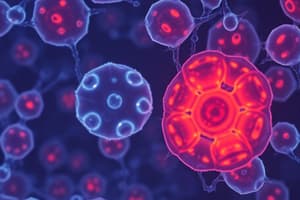Podcast
Questions and Answers
प्रोकैरियोटिक कोशिकाओं की औकात क्या है?
प्रोकैरियोटिक कोशिकाओं की औकात क्या है?
- 3 से 7 माइक्रोमीटर
- 10 से 15 माइक्रोमीटर
- 7 से 10 माइक्रोमीटर
- 0.1 से 3 माइक्रोमीटर (correct)
प्रोकैरियोटिक कोशिकाओं में आमतौर पर कौन-सा प्रकार का डीएनए होता है?
प्रोकैरियोटिक कोशिकाओं में आमतौर पर कौन-सा प्रकार का डीएनए होता है?
- त्रिभुजाकार
- घुमावदार (correct)
- पुनर्विभाजनशील
- अनुभागीय
प्रोकैरियोटिक कोशिकाओं की तुलना में यूकैरियोटिक कोशिकाएं किस दृष्टि से अधिक संरचित होती हैं?
प्रोकैरियोटिक कोशिकाओं की तुलना में यूकैरियोटिक कोशिकाएं किस दृष्टि से अधिक संरचित होती हैं?
- संवेग
- पुनर्विभाजन
- साइज
- संरचना (correct)
प्रोकैरियोटिक कोशिकाएं कौन-सा प्रमुख तरीके से पुनर्वासना करती हैं?
प्रोकैरियोटिक कोशिकाएं कौन-सा प्रमुख तरीके से पुनर्वासना करती हैं?
युकेरियोटिक कोशिकाओं की विशेषता में से कौन-सी सबसे सही है?
युकेरियोटिक कोशिकाओं की विशेषता में से कौन-सी सबसे सही है?
कौन-सा करकरी प्रोकैरियोटिक कोशिकाओं के साथ मुक़ाबला करता है?
कौन-सा करकरी प्रोकैरियोटिक कोशिकाओं के साथ मुक़ाबला करता है?
प्रोकैरियोटिक और युकेरियोटिक कोशिकाएं मुख्यतह क्या से भिन्न होती है?
प्रोकैरियोटिक और युकेरियोटिक कोशिकाएं मुख्यतह क्या से भिन्न होती है?
कौन-सा कारक प्रमुखत: प्रोकैरियोटिक कोशिकाओं में पाया जाता है?
कौन-सा कारक प्रमुखत: प्रोकैरियोटिक कोशिकाओं में पाया जाता है?
Study Notes
The Cell: Prokaryotic and Eukaryotic
Cells are the building blocks of life, and they come in two main types: prokaryotic and eukaryotic. These cells differ in their structure, size, and complexity, which has a significant impact on their functions and the types of organisms they inhabit.
Prokaryotic Cells
Prokaryotic cells are simpler in structure and smaller than eukaryotic cells. They lack a nucleus and other membrane-bound organelles, which means they do not have a defined internal structure. Some key features of prokaryotic cells include:
- Size: Prokaryotic cells are typically smaller than eukaryotic cells, measuring between 0.1 to 3 micrometers in diameter.
- Nucleus: These cells do not have a nucleus or other membrane-bound organelles, which means they do not have a defined internal structure.
- DNA: Prokaryotic cells have circular DNA that is not confined to a nucleus.
- Reproduction: These cells reproduce asexually by binary fission, where the cell grows and splits in half, forming two identical daughter cells.
Prokaryotic cells are mostly found in bacteria, cyanobacteria, and archaea, which are unicellular organisms that inhabit various environments, such as soil, water, and the human body. They play a crucial role in ecological processes, such as decomposition and nutrient cycling, and are essential for human health and medicine.
Eukaryotic Cells
Eukaryotic cells are more complex and larger than prokaryotic cells. They have a nucleus and other membrane-bound organelles, which gives them a defined internal structure. Some key features of eukaryotic cells include:
- Size: Eukaryotic cells are typically larger than prokaryotic cells, measuring between 10 to 100 micrometers in diameter.
- Nucleus: These cells have a nucleus and other membrane-bound organelles, which gives them a defined internal structure.
- DNA: Eukaryotic cells have linear DNA that is confined to a nucleus.
- Reproduction: These cells reproduce sexually, which involves the fusion of two different sets of chromosomes from two parents to create a genetically diverse offspring.
Eukaryotic cells are found in multicellular organisms, such as plants, animals, and fungi. They are essential for the growth, development, and functioning of these organisms, as they perform various tasks, including energy production, protein synthesis, and cellular communication.
In conclusion, prokaryotic and eukaryotic cells differ in their structure, size, and complexity, which has a significant impact on their functions and the types of organisms they inhabit. Understanding these differences is crucial for understanding the fundamental principles of biology and the diversity of life on Earth.
Studying That Suits You
Use AI to generate personalized quizzes and flashcards to suit your learning preferences.
Description
यह क्विज सेल के दो प्रमुख प्रकार प्रोकैरियोटिक और यूकैरियोटिक के बारे में है और उनके संरचना, आकार और जटिलता में अंतर पर चर्चा करता है।




